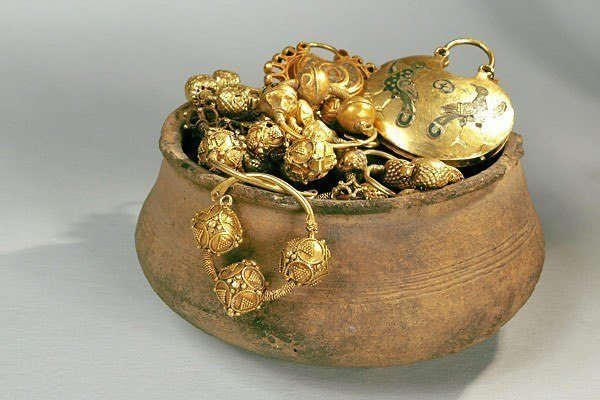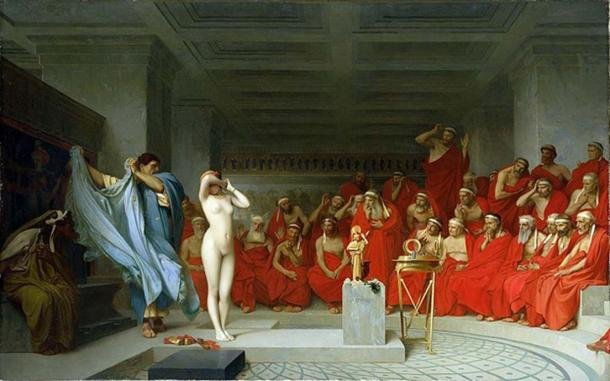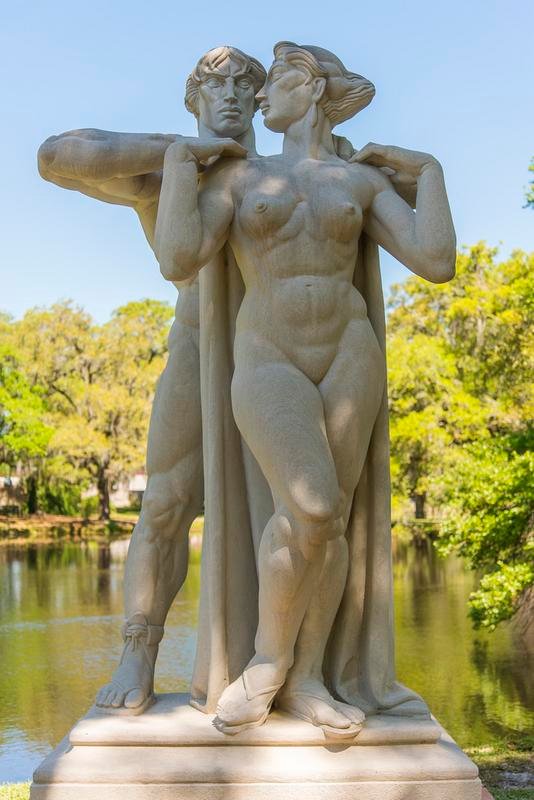Phryne: The Ancient Greek Prostitute Who Flashed Her Way to Freedom
Most of you have probably never heard of Phryne the Thespian, a famed courtesan of Athens, who's mainly remembered for the court case she won by baring her breasts. Her actual name was Mnesarete but people referred to her as Phryne (“toad”) because of the yellow complexion of her skin.

Source: Wikipedia
She was the daughter of Epicles from Thespiae (Boeotia), but spent most of her life in Athens. Even though we don’t know the exact dates of her birth and death, various historians estimate that she was born around 371 BC, the year Thebes razed Thespiae not long after the battle of Leuctra and expelled its inhabitants.
Thanks to her extraordinary beauty, she became a model posing for various painters and sculptors, including the great Praxiteles (who was also one of her clients). Actually, Praxiteles’s statue of Phryne was purchased by the city of Cnidus – after the city of Cos that had originally commissioned it, objected to its being nude – and became such a popular tourist attraction that the city managed to pay off its entire debt.
Phryne’s beauty also became the subject of many ancient Greek scholars, who praised her good looks, with Athenaeus providing the most details about Phryne’s life. He mentions in his work titled The Deipnosophists,

Source: Amazon
Phryne was a really beautiful woman, even in those parts of her person which were not generally seen: on which account it was not easy to see her naked; for she used to wear a tunic which covered her whole person, and she never used the public baths.
But on the solemn assembly of the Eleusinian festival, and on the feast of the Poseidonia, then she laid aside her garments in the sight of all the assembled Greeks, and having undone her hair, she went to bathe in the sea; and it was from her that Apelles took his picture of Aphrodite Anadyomene; and Praxiteles the sculptor, who was a lover of hers, modelled the Aphrodite of Cnidus from her body; and on the pedestal of his statue of Eros, which is placed below the stage in the theatre, he wrote the following inscription:
"Praxiteles has devoted earnest care
To representing all the love he felt,
Drawing his model from his inmost heart:
I gave myself to Phryne for her wages,
And now I no more charms employ, nor arrows,
Save those of earnest glances at my love.”
Athenaeus also recorded that Phryne was possibly the richest self-made woman of her time. She became so vastly rich at some point of her life that she offered to fund the rebuilding of the walls of Thebes, which had been destroyed by Alexander the Great in 336 BC.

Source: History In Orbit
She demanded that the words "Destroyed by Alexander, restored by Phryne the courtesan" would be inscribed on the walls. Intimidated of the idea that a woman – and for that matter not just any woman, but a prostitute – could rebuild what Alexander the Great had destroyed, Phryne's offer was rejected by the town's patriarchs and the walls remained in ruin.
Phryne's Trial
Despite her “divine” looks, incredible wealth, and famous lovers, what immortalized Phryne in the history books is undoubtedly her famous trial. Athenaeus writes that she was prosecuted for a capital charge and defended by the orator Hypereides, who was one of her lovers. He does not specify the nature of the charge, though some unverified historical sources (Pseudo-Plutarch) mention that she was accused of impiety.
Even though there’s a great dispute among historians about what really happened that day in the court, one of the most credible sources (that of Athenaeus) states that Hypereides tore off Phryne’s robes in the middle of the courtroom to show the judges her beautiful breasts. His reasoning was that only the Gods could sculpt a body so perfect and as such, killing or imprisoning her would be seen as blasphemy and disrespect to the Gods. Athenaeus mentions in The Deipnosophists,
Now Phryne was a native of Thespiae; and being prosecuted by Euthias on a capital charge, she was acquitted: on which account Euthias was so indignant that he never instituted any prosecution afterwards, as Hermippus tells us. But Hypereides, when pleading Phryne's cause, as he did not succeed at all, but it was plain that the judges were about to condemn her, brought her forth into the middle of the court, and, tearing open her tunic and displaying her naked bosom, employed all the end of his speech, with the highest oratorical art, to excite the pity of her judges by the sight of her beauty, and inspired the judges with a superstitious fear, so that they were so moved by pity as not to be able to stand the idea of condemning to death a prophetess and priestess of Aphrodite.
And when she was acquitted, a decree was drawn up in the following form: That hereafter no orator should endeavour to excite pity on behalf of any one, and that no man or woman, when impeached, shall have his or her case decided on while present.

Source: Ancient Origins
Verdict and Legacy of Phryne’s Trial
What seemed as a lost case for Phryne, turned quickly into a triumph for her after the inspired act by Hypereides. Phryne walked out the court victorious and her story went on inspiring several works of art, including the painting Phryne before the Areopagus by Jean-Léon Gérôme, from 1861, the 1904 painting Phryne, by José Frappa; the sculpture Phryné by French sculptor Alexandre Falguière; and the sculpture Phryne Before the Judges, by the American sculptor Albert Weine, from 1948.

Source: Fiveprime
More importantly, the famous hetaerae is seen by some scholars today as a symbol of freedom against repression disguised as piety, even though most of us will probably agree that some of her choices in life weren’t the most ideal or moral for a lady.
This article was written by me and was originally published at my blog theo-cracy.com and Ancient Origins. References
Cooper, C. (1995) Hyperides And The Trial of Phryne. Phoenix
The Editors of Encyclopædia Britannica (1999) Phryne The Legendary Greek Courtesan
Thanks for the article.
I just knew that she was a very famous hetaerae and ...that's it.
I also find it interesting that the actual name (Phryne-Φρύνη) is a somewhat common female name, both in Greece and in Cyprus. I wonder if it was it carried through the ages as a tribute to her or is just a recent "reinvention".
Now that's a great question. I have to do some research on it to find out. Thank you for the constructive comment my friend and welcome to Steemit :)
Δε ήξερα τίποτα από όλα αυτά! Ούτε ποioυ κόρη ήταν η Βοιωτία! :)
Καλημέρα φιλέ!!!!
Καλημερα μαν μου :)))))
That would have been cool if it happened.
I’m adding the deipnosophists to my reading list. Interesting article bro
Really cool book (I still haven't finished it)
She certainly was left off the hook of by the judges in the court room because of her profounding beauty, nevertheless the Greek history tend to always amaze me, everything is so intriguing
Looks pay the bills bruh ;)
Lol well her crimes may not be that bad, I will be sentencing her with my eyes closed should it be me
hahahahaha, good one ;)
Certainly too, you have an amazing blog brother, keep thrilling with them
Great post bro
Thanks bruh!
Its a good post,i had no idea about Phryne the Thespian, thanks to share this historical post.
Now you got an idea my friend ;)
Yeah thank you, would be glad if you visit my blog!
I did! Nice garden ;)
Thanks.
A Greek guy uncovering the margins of ancient Greek history! I love it :)
Well you were answering in Greek, so I just assumed. Maybe you're not, but you know the language.
How do you know I am Greek?
Great !
Collaborate a bit more here. Great how?
Elaborate* ;) but I agree. The urge to flag is real.
Elaborate right ;)
Had me wanting to read just with that title :) Well Done! Loved the read.